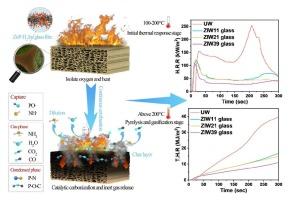ZnP-H2Im glass for flame retardant wood: In situ vitrification and synergistic mechanisms
IF 13.2
1区 工程技术
Q1 ENGINEERING, CHEMICAL
引用次数: 0
Abstract
A novel method for enhancing wood flame retardancy by in situ vitrifying ZnP-H2Im coordination polymer within wood was developed. ZnP-H2Im crystals were synthesized via double impregnation and then converted into a continuous and largely continuous glass film that fully coats the wood fibers using melting-quenching. The vitrification process was confirmed by SEM-EDS, XRD, and DSC. The cell wall thickness of the modified wood (ZIW39 glass) was 58.96 % greater than that of untreated wood. The plastic and glass transition peaks of ZnP-H2Im in the modified wood were detected. The heat treatment caused the ZnP-H₂Im to melt, as evidenced by the disappearance of its characteristic XRD peaks. The molten phase permeated the cell walls, forming a glass film that increased the cell wall thickness. The flame-retardant mechanism involves forming a physical barrier, melting to absorb heat, generating phosphoric acid to catalyze carbonization, and releasing inert gases. As a result, the total heat release in 300 s of ZIW39 glass was reduced by 72.38 % and the limiting oxygen index (LOI) was increased by 69.78 %. Notably, ZIW39 glass exhibited an exceptionally low leaching rate of only 2.65 % after 120 h of immersion. This approach, highlighting in situ vitrification and multiple flame-retardant mechanisms, overcomes limitations of conventional flame retardants. It offers an efficient, eco-friendly strategy for wood modification with industrial potential.

阻燃木材用ZnP-H2Im玻璃:原位玻璃化和协同作用机制
提出了一种原位玻璃化ZnP-H2Im配位聚合物增强木材阻燃性的新方法。通过双浸渍法合成ZnP-H2Im晶体,然后通过熔融淬火将其转化为连续且基本连续的玻璃膜,该膜完全覆盖在木材纤维上。通过SEM-EDS、XRD、DSC等手段证实了玻璃化过程。改性木材(ZIW39玻璃)的细胞壁厚度比未处理木材增加58.96 %。在改性木材中检测到ZnP-H2Im的塑料峰和玻璃峰。热处理导致ZnP-H 2 Im熔化,其特征XRD峰消失。熔融相渗透细胞壁,形成玻璃膜,增加细胞壁厚度。阻燃机理包括形成物理屏障、熔化吸收热量、产生磷酸催化碳化和释放惰性气体。结果表明,在300 s内,ZIW39玻璃的总放热量降低了72.38 %,极限氧指数(LOI)提高了69.78 %。值得注意的是,浸泡120 h后,ZIW39玻璃的浸出率非常低,仅为2.65 %。这种方法,突出了原位玻璃化和多种阻燃机制,克服了传统阻燃剂的局限性。它为具有工业潜力的木材改性提供了一种高效、环保的策略。
本文章由计算机程序翻译,如有差异,请以英文原文为准。
求助全文
约1分钟内获得全文
求助全文
来源期刊

Chemical Engineering Journal
工程技术-工程:化工
CiteScore
21.70
自引率
9.30%
发文量
6781
审稿时长
2.4 months
期刊介绍:
The Chemical Engineering Journal is an international research journal that invites contributions of original and novel fundamental research. It aims to provide an international platform for presenting original fundamental research, interpretative reviews, and discussions on new developments in chemical engineering. The journal welcomes papers that describe novel theory and its practical application, as well as those that demonstrate the transfer of techniques from other disciplines. It also welcomes reports on carefully conducted experimental work that is soundly interpreted. The main focus of the journal is on original and rigorous research results that have broad significance. The Catalysis section within the Chemical Engineering Journal focuses specifically on Experimental and Theoretical studies in the fields of heterogeneous catalysis, molecular catalysis, and biocatalysis. These studies have industrial impact on various sectors such as chemicals, energy, materials, foods, healthcare, and environmental protection.
 求助内容:
求助内容: 应助结果提醒方式:
应助结果提醒方式:


